Fundamentals of data representation
1/146
Earn XP
Description and Tags
number systems, number bases, units of information, binary number system, information coding systems, representing sound/ images
Name | Mastery | Learn | Test | Matching | Spaced |
|---|
No study sessions yet.
147 Terms
state the base number for denary, binary and hexadecimal
denary = base 10
binary = base 2
hexadecimal = 16
what is a natural number?
positive whole number, including 0
draw the symbol for a natural number

give an example for when natural numbers are used
counting (e.g. “there are 6 people here”)
ordering (e.g. “this is the 3rd largest city in the world”)
what is an integer number
whole positive OR negative number, including 0
draw the symbol for an integer number

what is a rational number
any number that can be expressed as a quotient, fraction or ration
draw the symbol for a rational number

what is an irrational number
number that cannot be represented as fraction or ration since the decimal form will contain infinite repeating values
give 2 examples of irrational numbers
pi
square root of 2

what is a real number
any positive OR negative number with OR without fractional part
draw the symbol for a real number

draw all the symbols for the number systems
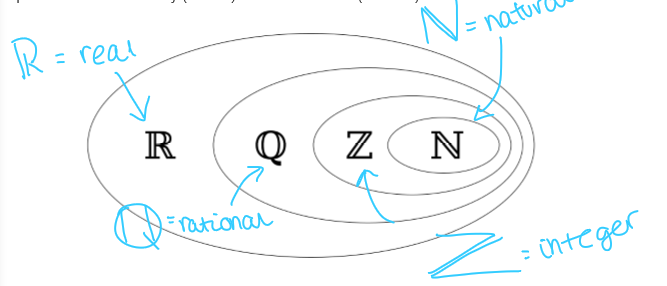
what is an ordinal number
number used to identify position relative to other numbers
ordinal = ORDER
e.g. first, second, third
what is a cardinal number
identifies size of something
e.g. number of elements in array or characters in string, second out of 20
state the name of the units in binary. how do they differ from the scientific name
binary: x 1024
kibi, mebi, gibi, tebi
scientific: x 1000
kilo, mega, giga, tera, peta
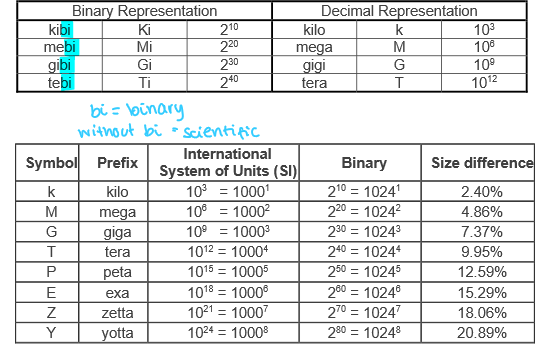
what is the formula to figure out how many digits can be stored with a certain number of bits
n bits = 2n digits

what is the largest number that can be stored in an n bit word
2n - 1
PRACTICE:
how many bits would it take to store the number 125
125 log2 = 6.96
…. therefore would need 7 bits
PRACTICE:
how many bits would it take to store the number 312
312 log2 = 8.2
…. therefore would need 9 bits
convert the denary number 37 into binary
divide number by 2.
take note of the remainder.
repeat until remainder = 0
read from bottom up (i.e. the last remainder that is 0 takes the larges placeholder e.g. 128)
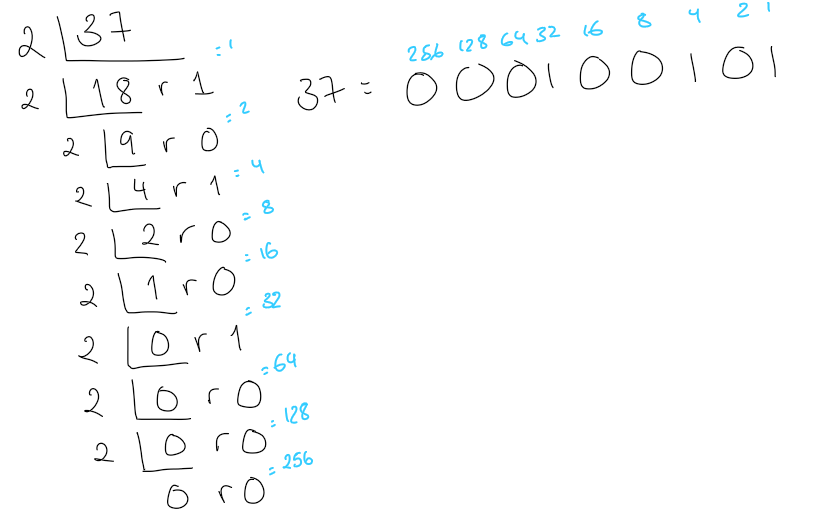
convert binary number 11001010 into denary
128 + 64 + 8 + 2 = 202
binary addition rules
0 + 0 = 0
0 + 1 = 1
1 + 1 = 0 carry 1
1 + 1 + 1 = 1 carry 1
how to multiply 2 binary numbers
multiply. then add.
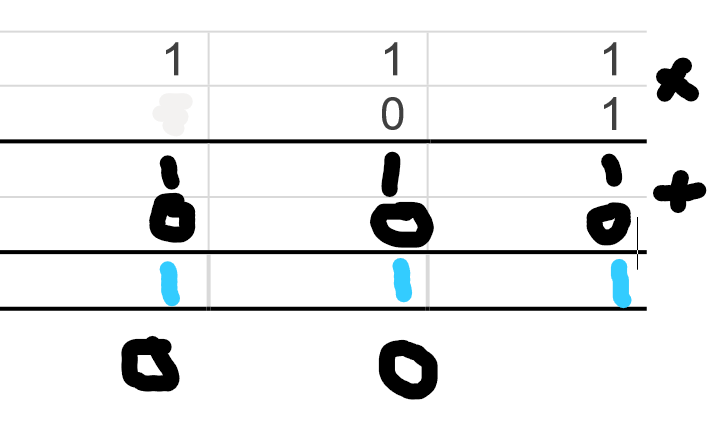
binary multiplication rules
0 × 1 = 1
1 × 1 = 1
how to represent unsigned and signed integers
if there is a 0 at the start = positive number
if there is a 1 at the start = negative number
rules for Two’s compliment
start from least significant end, copy bits up to and including the first 1
invert the remaining
how to convert -74 into Two’s compliment?
signed binary: -01001010
two’s compliment: 10110110
what is the method for subtracting binary numbers. use the example of 3 - 8
represent both numbers in binary
represent the second one in Two’s compliment
Add the first number to the negative second number
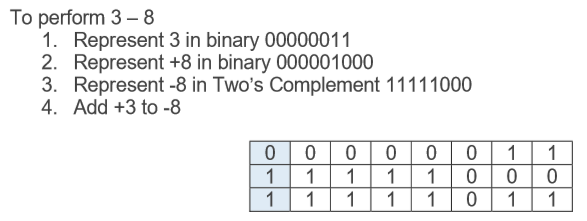
how to convert binary number into Hexadecimal
starting from least significant end, group binary number into blocks of 4
convert blocks into decimal
convert each decimal to hexadecimal
convert 01111110102 to hexadecimal

difference between fixed and floating point binary numbers
fixed: the decimal point is fixed so there is always the same number of integers before the decimal point and the same number of decimals places after the decimal point
floating: the decimal point is NOT fixed so it can be treated like standard form. uses a mantissa and exponent. have an exponent base of 2. mantissa is specified as point binary where binary point is placed in between most and least significant bit
evaluate using fixed point over floating point
+ makes arithmetic simple - therefore processing is faster
- it is of limited range
evaluate using floating point over fixed point
+ range of numbers that can be represented with set number of bits is far larger
how are decimal numbers represented in binary?

convert +54.16 into fixed point binary
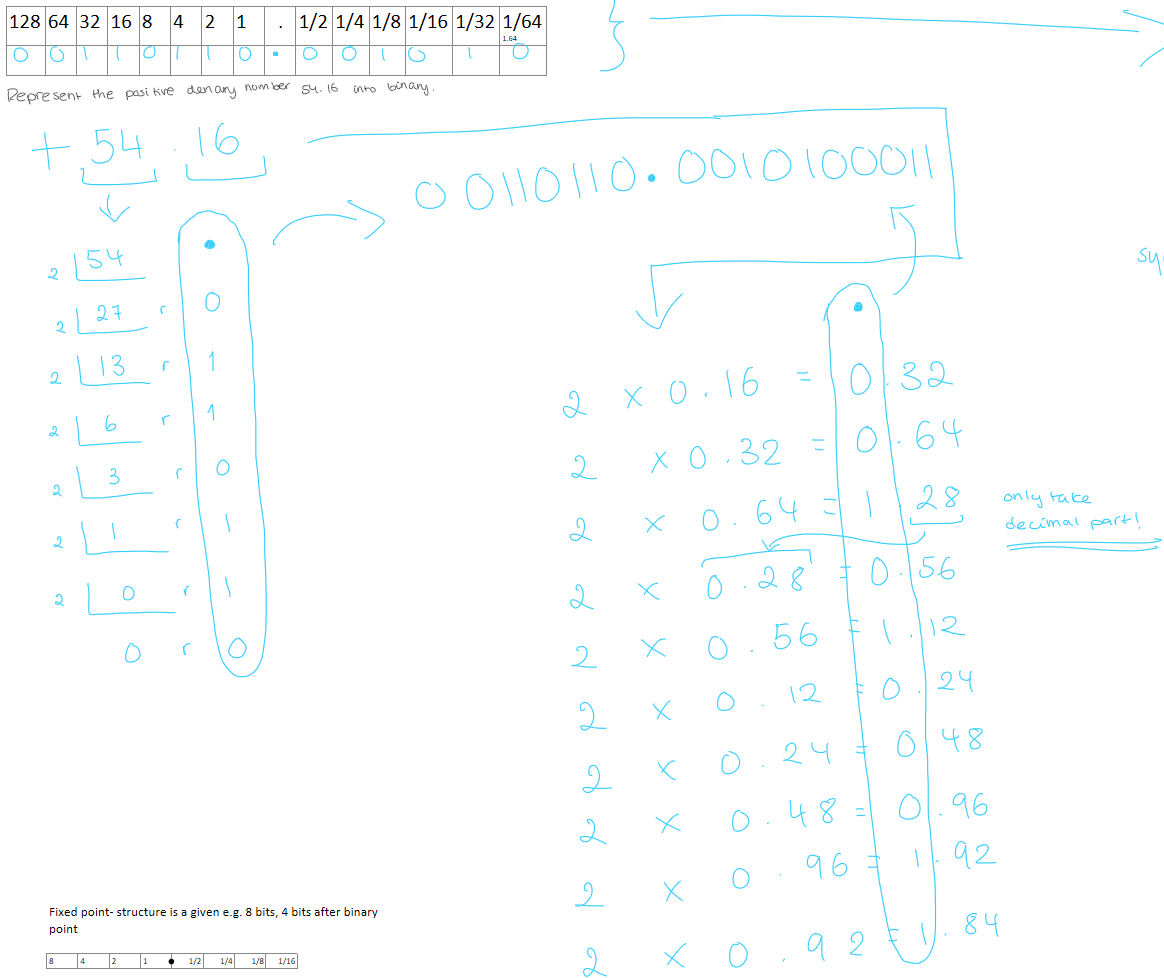
draw out the format for the mantissa and exponent:

effects of the size of the mantissa and exponent:
if the number of bits representing the mantissa is decreased and exponent s increased (keeping total number of bits the same) then:
range of numbers that can be represented is increased (EXPONENT DEPENDENT)
precision is decreased (MANTISSA DEPENDENT)
PREVIOUS EXAM QUESTION:
In an 8 bit mantissa, we can store 9 bits. How?
The first digit after the decimal point is the opposite of the first value because if it is a positive number, it will start 0.1 and if the number is negative, it starts with 1.0. Because of this, only the first value has to be stored and the one after can just be programmed to be the opposite. So, we can store an extra value in the 8 bit mantissa.

simplified method of normalising binary into floating point representation:
convert to binary
method for whole number= keep dividing whole number by 2 and note the remainder. first remainder is least significant digit
method for decimal part= times the decimal number by 2. every answer becomes the recurring number that is times by 2 (note: if answer = 1.55, times 2 by 0.55) until answer is 0.00. note the whole number of this process, the first digit calculated is the start of the decimal part
perform twos compliment if needed
copy up to and including first 1
normalise
if decimal point moves ← (left), exponent = positive
if decimal point moves → (right), exponent = negative
convert exponent into binary
perform twos compliment on exponent if negative (decimal moves backwards/ right .→)
write out answer in specified mantissa and exponent format
normalise the denary number 7.75 as the binary floating point number with an 8 bit mantissa and a 4 bit exponent
represent number in binary
00000111.1100
method for whole number= keep dividing whole number by 2 and note the remainder. first remainder is least significant digit
method for decimal part= times the decimal number by 2. every answer becomes the recurring number that is times by 2 (note: if answer = 1.55, times 2 by 0.55) until answer is 0.00. note the whole number of this process, the first digit calculated is the start of the decimal part
normalise
00.1111100
move decimal place to LEFT(positive move) by 3
needs to be +ve so has to start with 0.1
write move in standard form
00.1111100 × 23
convert the exponent into binary
00.1111100 × 20011
ANSWER:

normalise -7.25 in floating point binary with 8 bit mantissa & 4 bit exponent
convert to binary: -00111.0100
twos compliment: 11000.1100
normalise: 11.0001100 × 23
simplify: 1.0001100 × 20011
8 bit mantissa & 4 bit exponent = 1.00011000011
give the largest/ smallest positive/ negative numbers represented in normalised floating point
Largest positive we can represent = 0111.1111 = 7
Largest negative we can represent = 1000.0000 = - 8
Smallest positive we can represent = 0000.0000 = 0
Smallest negative we can have = 1111.1111 = - 0.0001

Advantage of normalised floating point numbers
gives unique representation of each number
maximises precision for given number of bits
increases range of numbers represented in given number of bits
can test for equality easier e.g. 0.101011 0100 is same as 0.110011 0100
uses standard form so can easily compare numbers based on exponent (which one is bigger/ smaller) - see example:
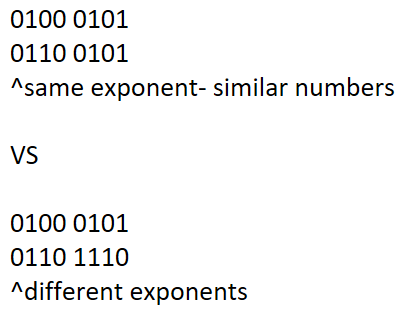
how to represent 9.125 and -1.25 in normalised floating point binary?
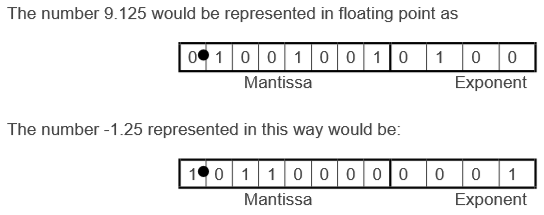
define precision
max number of significant digits that can be represented
(i.e. how close computer calculated value is compared to actual value)
fill in the gap:
the greater the mantissa, the more _________ we get
the greater the mantissa, the more precision we get
define rounding + give example of error
method used to change current number to new number which is closest to actual value
error = absolute error
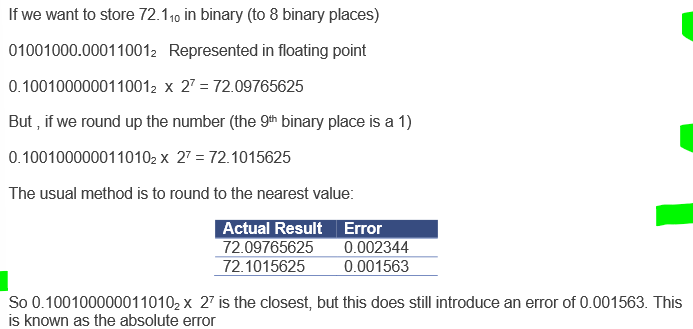
define absolute error
difference between actual number and nearest representable number
fill in the gap:
an absolute error will always be _________
an absolute error will always be positive
How to calculate absolute error
calculated number - actual number
how to calculate relative errors
absolute error / actual number
define cancellation error:
when two floating point numbers are added or subtracted in a way that the result is unchanged from the larger of the two numbers
explanation of what a cancellation error is:
Close to the real magnitude of the number BUT we remove the last couple digit at the end of the number. Keeping the expenses of the lower significance end for the higher significance end. LOOSING LEAST SIGNIFICANT BIT of our number
how cancellation errors happen with example:
two numbers of completely different magnitudes are subtracted
two numbers of equal magnitudes are subtracted

how can cancellation errors be avoided?
rearranging the equation in such a way that small numbers are not subtracted
define overflow
result of numeric calculation becomes too large to be stored in space reserved for numbers
state situations where overflow occurs
adding small number to very large number
multiplying two very large numbers together
define underflow
result of numeric calculation is too small to be represented by computer
state situations where underflow occurs
dividing small number by very large number
multiplying two very small numbers together (e.g. 1/128 × 1/128 = 1/16384)
how many bits is ASCII code & what does it represent
8 bits with the 8th bit being a parity bit
represent letters and symbols found on standard keyboard
why was extended ASCII created?
used all 8 bits (with no parity) so could increase number of characters represented to 28 (256) different combinations
How are ASCII codes grouped together?
0 - 31 = Control/ non printable characters (e.g. TAB)
32 - 127 = printable characters (punctuation, letters, digits)
extended ASCII: 128 - 255 = additional printable characters
every symbol has a unique binary code (even if it’s non printable)
how many bits does Unicode use & what additional features did it add from ASCII?
16 bits to represent each character
can store 216 (65536) characters
plane (page) 0 contain basic character sets, the 17 other pages are used for multilingual ideographics (e.g. emojis & heiroglyphics)
backward compatible with ASCII
What is UTF-8?
unicode transformation format
variable width character encoding system
capable of encoding all valid character codes in unicode using for 8-bit bytes
backwards compatible with ASCII
How does UTF-8 work?
first 128 characters correspond one-to-one with pure ASCII so can use 1 single byte
next 1920 characters need 2 bytes to cover almost all alphabets (e.g. Latin, Greek, Cyrillic)
3 bytes needed for characters in rest of basic multilingual plane (e.g. Japanese, Korean)
4 bytes needed for characters in other planes of Unicode (e.g. emjois, maths symbols)
outline RLE for text
run length encoding
form of lossless compression where aim is to reduce number of bits to represent set of data so text will take up less storage space & be quicker to transfer
runs through text & counts number of consecutive occurrences of each character

complete the run length encoding for this set of data:

negative compression
text with few repetitions will not compress well - compressed version uses more storage space than uncompressed version
possible solution to negative compression
use a special byte value which flags when run will occur. BUT, this does mean any run of bytes automatically has additional byte added to it
e.g.
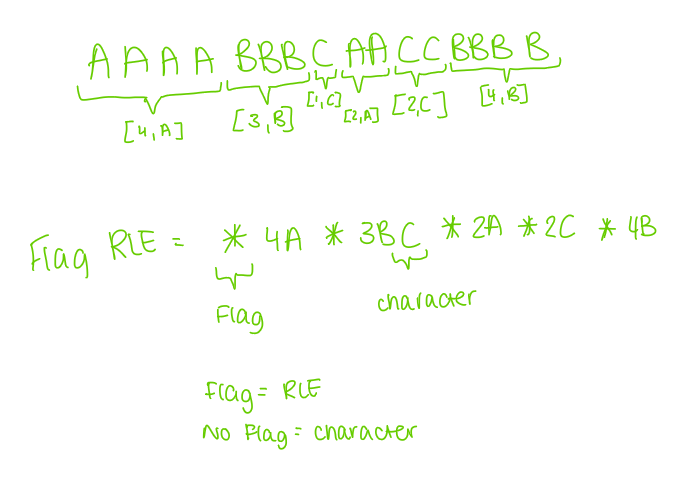
define bit-map images
images created when pixel of image are mapped to positions in memory that store binary codes representing colour of each pixel
define pixel
smallest addressable area of colour in image
define metadata and give examples for an image
data about the data
e.g. height, width, no. of colours, date, time, location
define resolution
number of pixels which appear per inch/ cm of image
higher the resolution…
better quality of image
closer can zoom without image becoming pixilated/ distorted
define colour depth
number of bits being used to store value/ colour of each pixel
the greater the size
higher the colour depth…
the greater the variety of colours available to be used
the greater the size

work out number of bits to store 256 colours = log2(256) = 8 bits
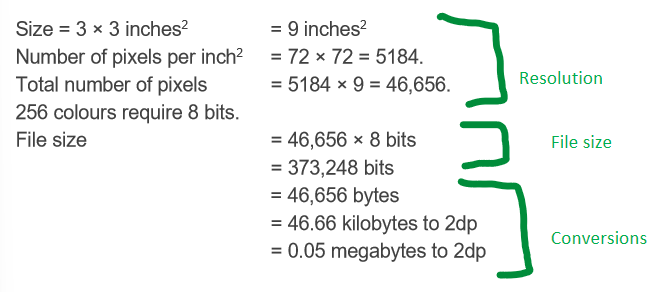
calculation for file size of bitmap image:
resolution x colour depth
calculates it in BITS
what are vector graphic images
images made up of objects & coordinates
how do bit-map and vector graphic images DIFFER?
bit-map: holds info on value of each individual PIXEL (e.g. colour depth)
vector graphic: holds details of lines & shapes that make up image (e.g. squares, circles)
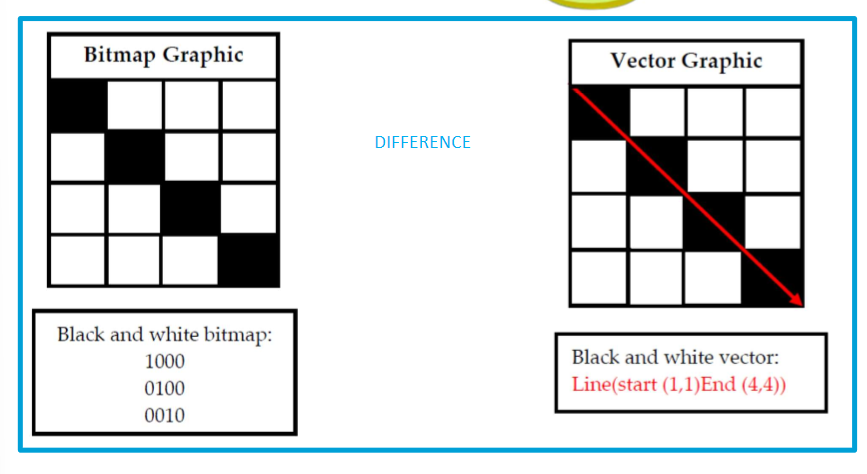
How are vector graphic images stored?
start and end coordinates of line are stored and computer interprets them as a line of given colour and width between these points
each pixel on output device is turned on when line crosses it to create visual image
advantage of vector graphics over bit-map images
they are scalable
vector graphics simply scale coordinates and shapes so individual pixels on output device are not affected
if you increase size of bitmap image, size of individual pixels must increase leading to pixilation
EXAM Q: write out the supposed data structure of storing info about vector object
can be a stack to produce layers which can move back and forth

comparing bitmap vs vector graphic images:
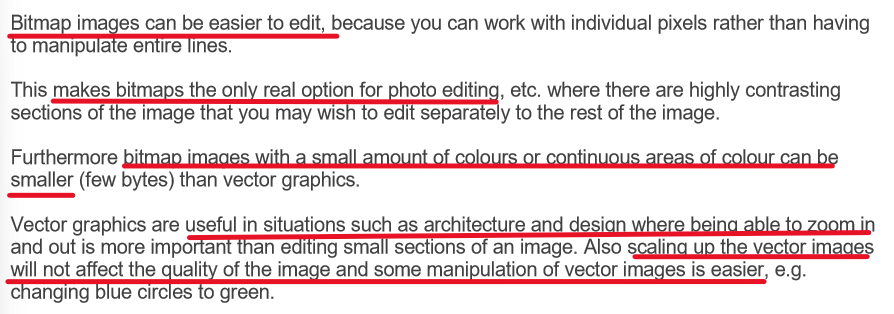
state the 2 compression techniques and how they reduce file size
lossless
can convert original files into condensed form AND use the inverse algorithm to convert it back
no loss of data
lossy
permanently removes data when compressing a file so original & decompressed files are not identical
state 2 methods of lossless compression
run-length encoding
dictionary- based encoding
how does run-length encoding operate with images?
eliminates repeating data
if 3 or more consecutive pixels contain same bit pattern, a ‘run of cells’ has been found that can be encoded into 2 bytes
first byte = run/ number of identical consecutive memory cell bytes
second byte= colour of run
how does dictionary-based encoding work?
within data, there are common repeating groups replaced with a token
e.g. :
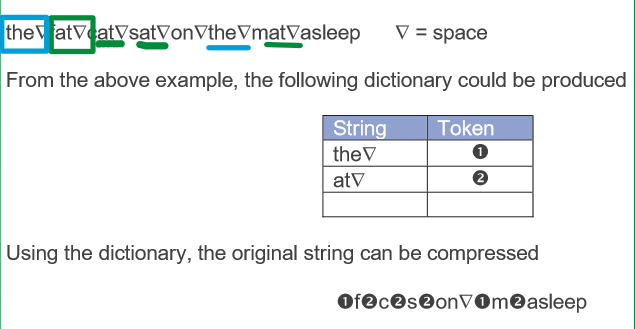
state a method of lossy compression
JPG
state ways in which we can represent sound:
-analogue signal (electrical signal that varies in continuous manner)
-digital data (data takes form of discrete values)
how is sound created and used in sound systems?
air pressure wave → sensed by ears → pressure wave captured by transducer (microphone) → produces electrical voltage/ current → transmitted through telephone/ broadcast through radio/ preserved on magnetic tape → electrical signal recreates sound by vibrating mechanical surface in loudspeaker → produces original pressure wave with varying degrees of fidelity → we hear this
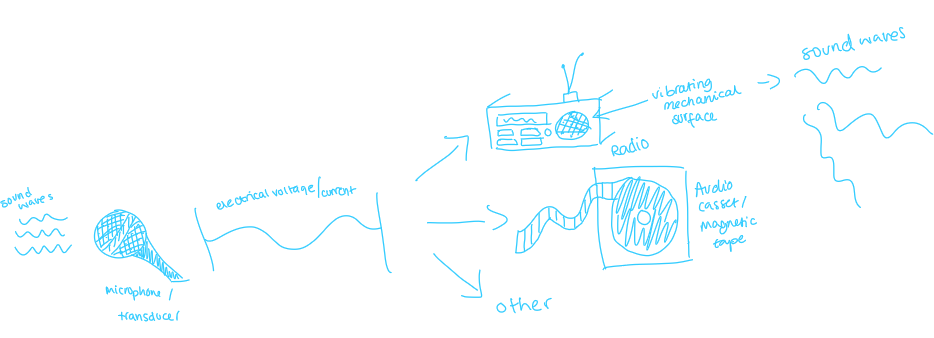
how does a vinyl LP record exploit shape of sound?
fixes similar shape in long spiral grove (stores data about sound in analogue form) on surface of record
when record played, fine needle follows changes in groove & creates electrical signal proportional to changes
then, signal is amplified & fed to loudspeaker
what is the purpose of a transducer? give examples
converts energy from one form to another
e.g. microphone: converts continuously varying sound pressure WAVES into continuously varying ELECTRICAL SIGNAL
e.g. loudspeaker: converts electrical energy to sound energy
the higher the pitch of the sound…
the more rapid/ frequent the vibration
the higher the loudness of sound…
the higher the amplitude of the soundwave
audio cd

define analogue quantities
physical quantities that vary continuously
e.g. temperature & pressure
define analogue data
data which varies in continuous manner
e.g. speech conveyed from speaker to listener by sound waves
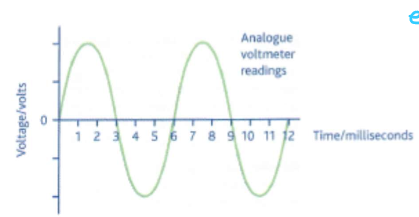
define digital data
discontinuous, varying data. discrete values
when analogue waves are sampled, they become digital